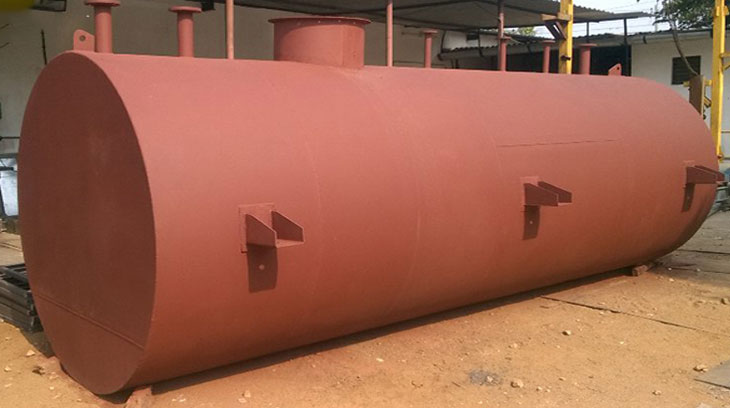
High-Speed Diesel (HSD) is a vital fuel in various sectors, including transportation, industrial, and commercial applications. The storage and efficient management of HSD are crucial for ensuring uninterrupted operations and maintaining safety standards. HSD storage tanks play a pivotal role in this process, serving as a primary reservoir for storing and dispensing diesel fuel. This essay aims to delve into the intricacies of HSD storage tanks, highlighting their design, functionality, and importance in fuel management systems.
HSD storage tanks are engineered with precision to meet stringent safety and operational requirements. These tanks come in various shapes and sizes, ranging from cylindrical to rectangular designs, depending on factors such as available space, storage capacity, and environmental considerations. Common materials used in the construction of HSD storage tanks include steel, fiberglass, and concrete, each chosen for its durability, corrosion resistance, and compatibility with diesel fuel.
Double-Wall Construction: Many modern HSD storage tanks are equipped with double-wall construction to prevent leaks and contain spills. The outer wall acts as a secondary barrier, providing additional protection against environmental hazards and corrosion.
Ventilation Systems: Proper ventilation is essential to prevent the buildup of harmful vapors and maintain optimal conditions within the tank. Ventilation systems, including vents, breathers, and pressure-relief valves, help regulate air circulation and ensure safe storage of diesel fuel.
Leak Detection and Monitoring: Advanced HSD storage tanks are equipped with leak detection systems to promptly identify any potential leaks or spills. Automated monitoring technologies, such as sensors and alarms, provide real-time alerts to operators, allowing for immediate corrective action.
Cathodic Protection: To mitigate corrosion and prolong the lifespan of the tank, cathodic protection systems are often employed. These systems use sacrificial anodes or impressed current to prevent the degradation of metal surfaces and maintain structural integrity.
HSD storage tanks serve multiple functions within fuel management systems, facilitating the storage, distribution, and dispensing of diesel fuel. Their primary functionalities include:
Storage: HSD storage tanks serve as primary reservoirs for storing bulk quantities of diesel fuel, ensuring a continuous supply to meet operational demands. Proper storage is essential to prevent contamination, degradation, and loss of fuel quality over time.
Dispensing: HSD storage tanks are equipped with dispensing systems, including pumps, meters, and hoses, to facilitate the transfer of diesel fuel to vehicles, equipment, and machinery. These dispensing systems are designed for efficiency, accuracy, and user convenience, enabling seamless refueling operations.
Inventory Management: Effective inventory management is critical for optimizing fuel usage, minimizing losses, and ensuring sufficient reserves for operational needs. HSD storage tanks are equipped with monitoring and tracking systems to manage inventory levels, track consumption patterns, and facilitate timely replenishment.
Compliance and Safety: HSD storage tanks are subject to stringent regulatory standards and safety protocols to safeguard against environmental hazards, fire risks, and health hazards. Compliance with regulations, such as those set forth by environmental agencies and industry standards, is paramount to ensure safe handling, storage, and transport of diesel fuel.
The significance of HSD storage tanks in fuel management systems cannot be overstated. Their importance lies in:
Ensuring Fuel Availability: HSD storage tanks provide a reliable and accessible source of diesel fuel, ensuring uninterrupted operations for various industries and applications, including transportation, construction, agriculture, and power generation.
Mitigating Risks: Proper storage and handling of diesel fuel are essential for mitigating risks associated with spills, leaks, and contamination, which can pose environmental hazards, endanger public health, and incur significant cleanup costs.
Optimizing Operations: HSD storage tanks enable efficient inventory management, allowing businesses to monitor fuel usage, track consumption trends, and optimize refueling schedules to minimize downtime and maximize productivity.
Promoting Sustainability: By adhering to strict environmental standards and implementing best practices in fuel management, HSD storage tanks contribute to sustainability efforts by reducing emissions, conserving resources, and minimizing environmental impact.
HSD storage tanks are integral components of fuel management systems, serving as critical infrastructure for storing, dispensing, and managing diesel fuel. Their robust design, advanced functionalities, and compliance with safety standards ensure the safe and efficient operation of various industries and applications reliant on HSD. As the demand for diesel fuel continues to grow, the role of HSD storage tanks in maintaining fuel supply chains and promoting sustainable practices remains indispensable.
Contact Us